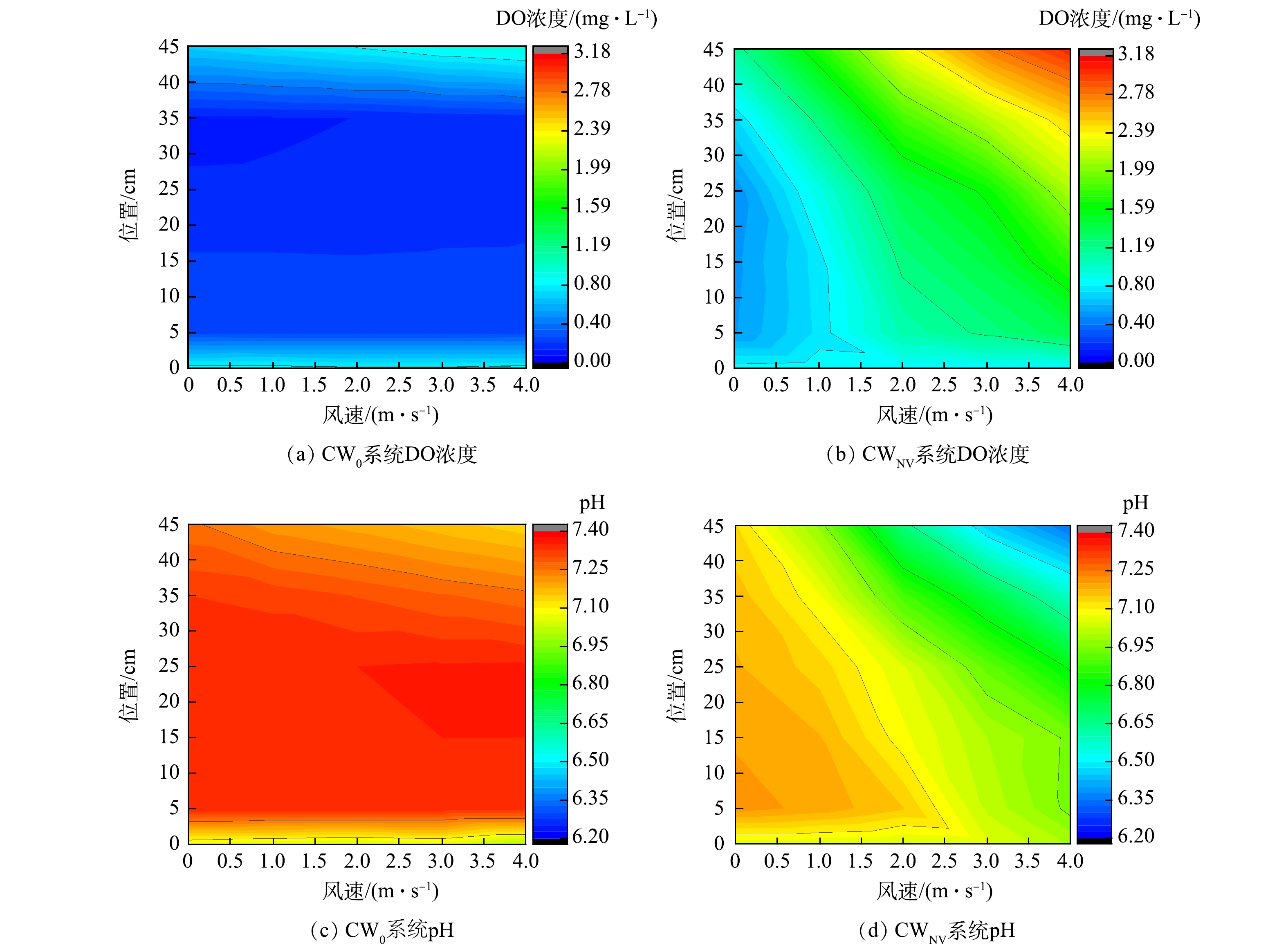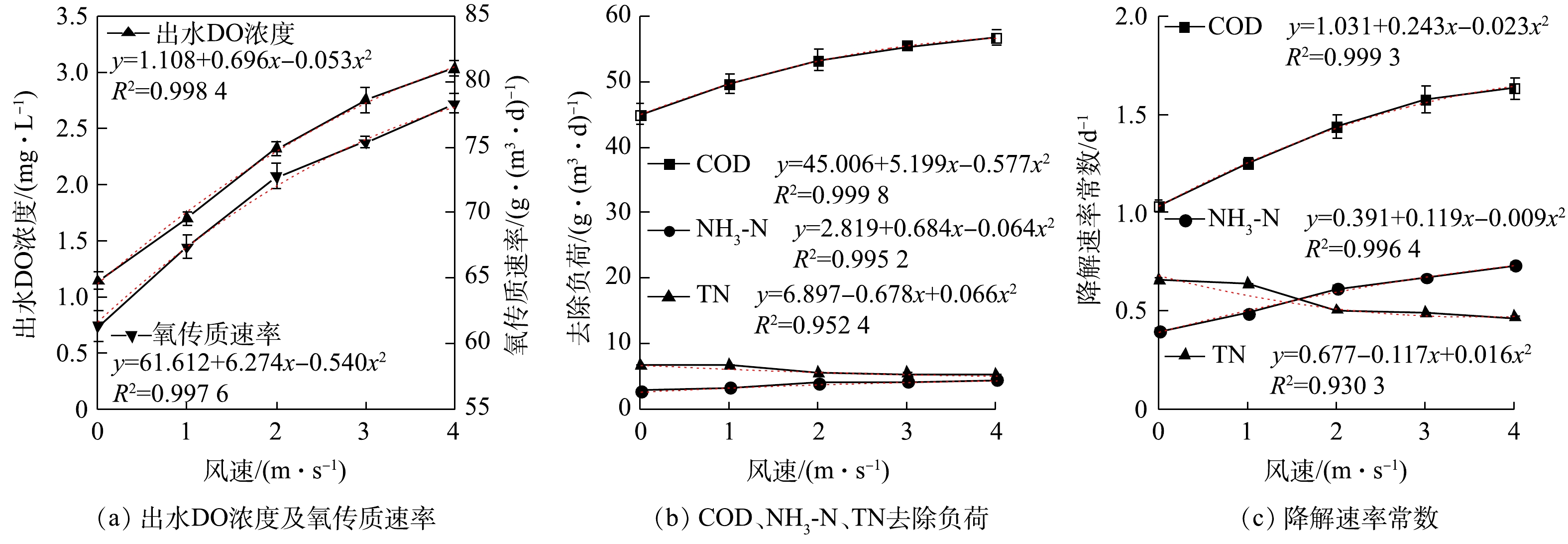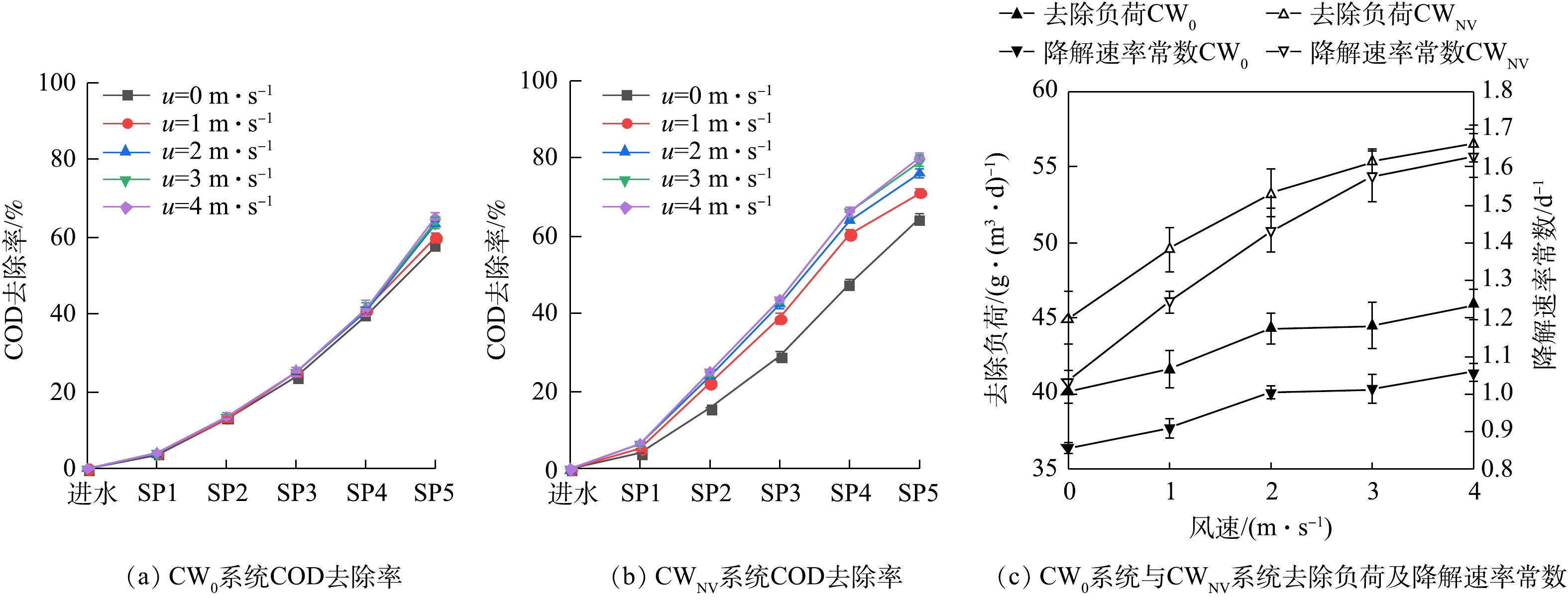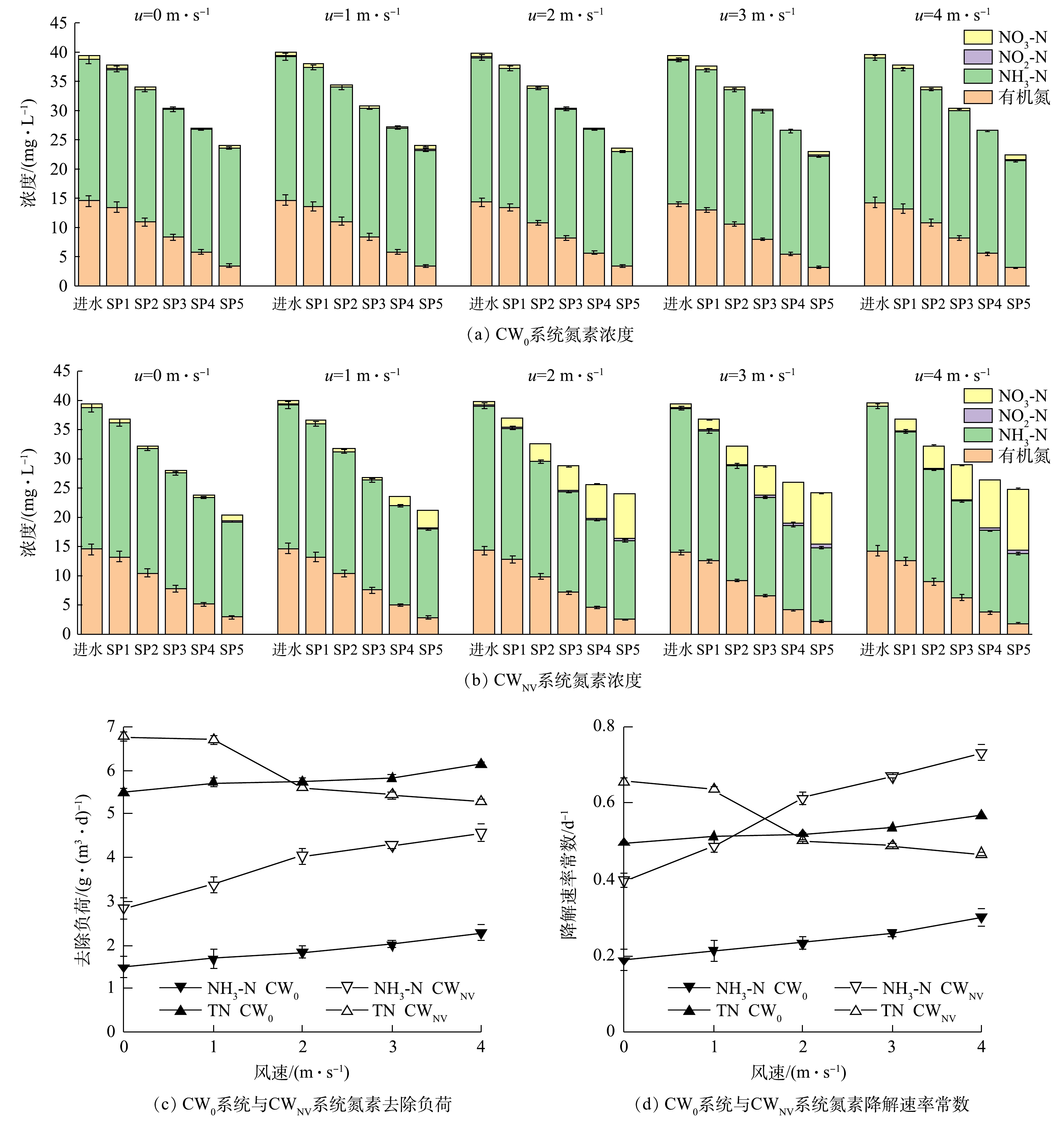-
人工湿地(constructed wetland, CWs)被认为是一种环境友好、操作灵活且具有成本效益的污水处理技术,其适用于多种类型的污废水处理,尤其是在中小型社区[1-4]。CWs利用系统中植物、填料和微生物之间的物理、化学、生物三重协同作用对污水进行高效净化[5-6]。传统CWs对有机物和悬浮物的去除效果较好,但对总氮(TN)的去除率较低,仅约30%~55%[7-9]。CWs中的氮可通过植物吸收、填料吸附、氨(NH3-N)挥发以及微生物转化等作用去除,其中,超过50%(60%~95%)的氮去除是通过微生物硝化-反硝化作用实现的[6,10-11]。但传统CWs复氧能力较差,导致硝化作用不充分,使得硝化成为湿地脱氮的限制步骤[9,12]。湿地内部溶解氧(dissolved oxygen, DO)主要来源于污水中的DO、大气表面复氧和植物根系泌氧作用,但由于湿地长期处于淹水状态,湿地填料表层的好氧区深度一般小于1 cm[7],植物根系泌氧所形成的好氧微环境只存在于根系周围约1 mm范围内[13],通常污水中DO浓度也较低,因此,传统人工湿地的复氧能力较差。
为强化人工湿地的硝化作用,可采取人工曝气(连续曝气或间歇曝气)、组合人工湿地系统、间歇进水、多点进水、出水回流、折流流动、虹吸补氧、太阳能曝气、跌水曝气或者自然通风曝气等措施。上述方式在一定程度上均可提高湿地系统内部DO含量进而强化其硝化作用,其中,相较于人工曝气或控制CW内水流流动方式,自然通风曝气其操作管理更为简单方便且几乎无需外加能耗,经济效益更为显著,也更适于农村以及偏远地区生活污水处理。LEE等[14]构建了垂直-水平流组合CW系统,前置垂直流CW系统内部埋设有通风管,太阳能和风能作为能量来源驱动电动风扇通过通风管为前置垂直流CW通风曝气,后置垂直流CW系统无通风曝气,结果显示,前置垂直流CW系统出水DO高达(6.97±1.3) mg·L−1、后置水平流CW系统出水DO为(1.61±0.23) mg·L−1、组合CW系统的TN去除率平均提高了16.6%。朱国平等[15]提出了一种人工湿地无动力充氧装置,在实施中将其用于处理农村生活污水,其中,好氧湿地槽内设置有拔风管,通过湿地内外的温度差、主要管道端口的高度差和烟囱效应的共同作用,实现空气自下而上的自由流通,而空气流通过程中通过装置上的空气扩散孔结合空气在湿地内部的扩散势能实现空气在湿地内部的流通、扩散,利用该无动力充氧装置可使好氧湿地槽中始终保持DO浓度为1.5~2.0 mg·L−1,充氧效果明显;好氧湿地槽出水再流经厌氧湿地槽,厌氧湿地槽中不设置拔风管,整体维持兼氧、厌氧条件,污水经上述系统处理后,出水指标优于《城镇污水处理厂污染物排放标准》一级A标准。POZO-MORALES等[16]在水平潜流人工湿地系统内部设置了由通风井和通风烟筒构成的推流式强制自然通风回路,依靠水流推流式流动和对外部空气的抽吸作用,可实现系统内部良好的通风效果,该系统的进水有机负荷是传统CW系统的4倍,有机物去除效果良好。
综上所述,采用自然通风可有效提高CW系统内部DO浓度,进而强化其污染物去除效果。但是,目前关于自然通风型CW系统的研究较为初步,主要集中在系统出水DO浓度值及对污染物的最终去除效果方面,系统内部溶解氧输移扩散变化规律尚不清楚,且还未有关于风速与CWs中氧传质速率以及污染物(有机物、氮、磷)的去除效果之间关系的定量研究。而研究自然通风条件对CW系统内部DO输移扩散变化的影响规律,可通过控制通风条件改善基质内部不同深度上的氧化还原状态,从而调节微生物种群的分布,进而控制污染物的形态转化与去除,这对于进一步提高CW系统的污染物去除效果意义重大。
基于此,本研究主要解析了自然通风型CWs系统内部溶解氧输移扩散变化规律以及污染物浓度和去除率在系统内部的沿程变化;考察了风速与氧传质速率以及有机物、氮、磷去除负荷之间的定量关系,以期为自然通风型CWs系统的设计和运行提供参考。
全文HTML
-
本研究中升流式潜流CW装置结构如图1所示(即自然通风型人工湿地CWNV和传统人工湿地CW0)。该装置由有机玻璃加工而成,高为0.5 m、内径为0.19 m。湿地内填料整体高度为0.45 m,自下而上依次为石灰石(高为0.05 m,粒径为10~20 mm)、轻质多孔陶粒(高0.10 m,粒径9~13 mm)、火山岩(高0.20 m,粒径5~8 mm)、河沙(高0.10 m,粒径2~4 mm),填料层平均空隙率为0.40。在不同的填料层均设置有取水口(SP1~SP5),分别位于距填料底部0.05、0.15、0.25、0.35和0.45 m处。2套装置共用1个进水箱,进水箱为0.7 m×0.5 m×0.5 m(长×宽×高)的PVC塑料箱。
CWNV装置内部安装有拔风管。如图1(b)所示,拔风管(内径15 mm)由一个横管(长0.16 m)和连接于其上的2个竖管(长0.80 m)构成;在CW内部的竖管(高0.45 m)管壁上布满通风孔(直径为3 mm),1 m3填料的通风面积约为1.08 m2;竖管上方5~10 cm处安装有扇叶片,扇叶片由风能和太阳能驱动旋转,可直接将风输送进入拔风管,从而为湿地内部通风供氧。CW0装置作为对照组,其内部未安装拔风管,但其填料表面上方相同位置处仍安装有扇叶片,以对比相同风速条件下CW0与CWNV系统内部的DO分布情况。参考天津市年平均风速,本研究中风速取值为0~4.0 m·s−1。
本研究中湿地植物选用美人蕉,种植密度为25株·m−2。幼苗栽种完成后,向装置内充注自来水至填料表面。为满足植物生长发育的需求,在上述自来水中加入15 mg·L−1 NH4Cl、15 mg·L−1 KH2PO4、15 mg·L−1 CaCl2·2H2O和15 mg·L−1 MgSO4·7H2O。上述化合物均为分析纯。在美人蕉幼苗生长阶段,视装置内水位高度情况随时补充水源,以促进植物和微生物群落的生长。考虑到装置位于室内,利用全光谱植物灯模拟太阳光,其每天开关各12 h。30 d后,将合成生活废水经由蠕动泵连续注入装置内以启动实验。装置内污水的有效水力停留时间为1 d。系统运行稳定后(实验启动约14 d后),开始采集水样并进行测定分析。实验周期为2019年10月—2020年3月,期间日平均气温为18.5~21.2 ℃、装置日平均蒸散量为1.65~2.52 mm·d−1。
-
生活污水采用蛋白胨、葡萄糖、尿素、NH4Cl、KH2PO4、Na5P3O10、MgSO4·7H2O和 CaCl2·2H2O(除蛋白胨外均为分析纯)配置。实验进水水质为:pH=6.91~7.11、化学需氧量(以COD计)为188.8~203.5 mg·L−1、总氮(TN)为38.68~41.00 mg·L−1、氨氮(NH3-N)为23.50~25.24 mg·L−1、有机氮为12.97~16.51 mg·L−1、总磷(TP)为4.86~5.07 mg·L−1、正磷盐酸(
${\rm{PO}}_4^{3-} $ -P)为3.84~4.09 mg·L−1、聚磷盐酸(${\rm{P}}_3{\rm{O}}_{10}^{5-} $ -P)为0.80~1.20 mg·L−1。 -
每2 d采集1次水样并进行检测,水质检测指标及分析方法为:使用便携式多参数测定仪(型号DZB-712F,上海仪电科学仪器股份有限公司)测定pH和DO;使用数字式风速仪(型号Thinrad TA-2,星瑞达科技有限公司)测定风速;采用快速消解分光光度法测定COD;采用过硫酸钾消解-钼锑抗分光光度法测定TP;采用碱性过硫酸钾消解-紫外分光光度法测定TN;采用纳氏试剂分光光度法测定NH3-N;采用N-(1-萘基)-乙二胺分光光度法测定亚硝态氮(
${\rm{NO}}_2^ - $ -N);采用紫外分光光度法测定硝态氮(${\rm{NO}}_3^ - $ -N);有机氮浓度为TN与无机氮(NH3-N、${\rm{NO}}_2^ - $ -N、${\rm{NO}}_2^ - $ -N)浓度之差,COD及N、P的检测使用多参数水质测定仪(型号MI-200H,天津众科创谱科技有限公司)。每份水样的每个指标均读数3次,取其平均值。 -
采用污染物去除率和去除负荷表征CW系统中污染物去除效果,分别根据式(1)和式(2)进行计算。
式中:RC表示污染物去除率;Ci表示平均进水浓度,mg·L−1;Ce表示平均出水浓度,mg·L−1。
式中:RL表示污染物去除负荷,g·(m3·d)−1;qi表示平均进水流量,m3·d−1;qe表示平均出水流量,m3·d−1;V表示湿地填料总体积,本研究中为0.013 m3。
由于装置蒸散量较小(1.65~2.52 mm·d−1),故可认为qi与qe相等。
采用一级动力学反应模型(式(3))计算COD、NH3-N、TN和TP的降解速率。
式中:k表示污染物降解速率常数,d−1;t表示水力停留时间,d。
氧传质速率(oxygen transfer rate, OTR)根据式(4)计算[17]。
式中:O表示氧传质速率OTR,g·(m3·d)−1;
${C_{{\rm{CO}}{{\rm{D}}_{{\rm{in}}}}}} $ 表示进水COD平均值,mg·L−1;${C_{{\rm{CO}}{{\rm{D}}_{{\rm{out}}}}}} $ 表示出水COD平均值,mg·L−1;${C_{{\rm{TKN}}_{{\rm{in}}}}} $ 表示进水凯氏氮平均浓度,mg·L−1;${C_{{\rm{TKN}}_{{\rm{out}}}}} $ 表示出水凯氏氮平均浓度,mg·L−1。本实验中所有数据均使用Microsoft Excel进行整理、使用IBM SPSS Statistics 20软件进行分析、使用OriginPro 8.5软件进行制图。通过方差分析(analysis of variance,ANOVA)表征所研究因素对CW-MFC系统性能影响的统计学显著性(P<0.05),对于3组及3组以上的数据,进行Duncan 事后检验(P<0.05)以分析多组样本间的差异显著性。
1.1. 实验装置
1.2. 进水
1.3. 监测分析方法
1.4. 数据处理与分析
-
在不同风速条件下CW0和CWNV系统中DO浓度分布如图2(a)和图2(c)所示。进水DO浓度为0.78~0.80 mg·L−1。对于无自然通风的CW0系统,只有填料表面(SP5)DO浓度(0.69~0.95 mg·L−1)随着风速的增加而增加,而其内部(SP1~SP4)的DO浓度(<0.5 mg·L−1)沿着水流方向不断下降,并且与风速无关。这主要是由于内部填料颗粒传质阻力较大,使得空气在CW0系统中的扩散范围十分有限,仅能在表面填料颗粒的空隙中扩散,从而使得CW0系统内部基本处于缺氧/厌氧状态。对于自然通风型CWNV系统,即使在无风(u=0 m·s−1)情况下,其内部(SP1~SP4)DO浓度(0.53~0.72 mg·L−1)也较CW0显著(P<0.05)高出0.27~0.60 mg·L−1,而其填料表面(SP5) DO浓度(1.14 mg·L−1)也较CW0显著(P<0.05)高出0.45 mg·L−1,这表明拔风管可有效连接湿地内部与外部大气,且随着风速增大,CWNV系统内部DO浓度沿水流方向不断增加:当风速为1.0 m·s−1时,CWNV系统内部0~25 cm处(SP1~SP3)DO为0.75~0.90 mg·L−1、35~45 cm处(SP4~SP5)DO为1.24~1.70 mg·L−1,同时存在缺氧/厌氧与好氧环境;当风速超过2.0 m·s−1时,整个CWNV系统处于好氧状态,平均DO浓度为1.08~3.03 mg·L−1。当风速由1.0 m·s−1增大到4.0 m·s−1时,CWNV与CW0内部的平均DO浓度之差由0.50~1.12 mg·L−1增大到1.12~2.30 mg·L−1,这表明外部空气可通过拔风管上的孔口有效地扩散和溶解到湿地内部。此外,CWNV内部DO浓度随着与填料表面距离的增加而降低,这种氧气扩散随距离的衰减主要源于填料、生物膜和悬浮物颗粒的阻力以及污染物降解的消耗[18]。此外,本研究中自然通风型CWNV系统平均出水DO浓度(1.14~3.03 mg·L−1)高于POZO-MORALES等[16]研究中推流式强制自然通风型CW系统的出水DO浓度(0.55 mg·L−1),且与朱国平等[15]研究中无动力充氧CW的出水DO浓度(1.5~2.0 mg·L−1)相近,但低于LEE等[14]研究中前置通风型垂直流CW系统出水DO浓度((6.97±1.3) mg·L−1)。
CW0和CWNV系统内部pH沿程变化如图2(b)和图2(d)所示。结合图2(a)和图2(c)分析可知,系统内部pH随DO浓度的增加而降低。CWNV系统内部pH(6.35~7.21)较CW0 (7.13~7.35)低0.14~0.79个单位,且CWNV表面(SP5)DO浓度最高(3.03 mg·L−1)、pH最低(6.35),但是,CW0和CWNV系统内部pH变化有限,最高仅相差0.86个单位(CWNV内)。这种pH随DO浓度增加而降低的变化趋势可归因于硝化作用。
表1列出了CW0和CWNV系统在不同风速条件下的平均OTR值。由表1可知,CW0和CWNV系统的OTR均随着风速的增大而增大,但CWNV的增幅显著高于CW0。即使在无风条件下,与CW0相比,CWNV系统内部拔风管也可显著(P<0.05)将其OTR提高约19.3%。当风速增大到1.0 m·s−1时,CWNV 的OTR较CW0高出25.7%;当风速为2.0~4.0 m·s−1时,CWNV的OTR较CW0高出30.4%~33.5%,但其增幅有所减缓,这进一步证明了自然通风系统可有效提高湿地内部复氧能力。
如图3所示,采用一元二次回归方程描述CWNV出水DO浓度、系统OTR、污染物(COD、NH3-N和TN)去除效果与风速之间的关系,并通过对比系统在风速为3.5 m·s−1和4.5 m·s−1的条件下的实测值和预测值,对回归模型进行验证,结果如表2所示。由表2可知,在所选定的2种风速条件下,出水DO浓度与OTR值的预测值较实测值的绝对偏差分别为−0.94%~−0.68%和0.42%~−1.35%,偏差值均较小。由此可见,基于实验结果,所得一元二次回归方程对CWNV系统在不同风速条件下的出水DO浓度和OTR值具有较好的预测效果。
总之,自然通风可有效强化湿地内部氧气传递扩散,从而显著提高其复氧能力,且其成本低廉、维护简便。在本研究中,当风速u≤1.0 m·s−1时,CWNV系统内部可同时存在缺氧/厌氧与好氧环境;而当风速≥2.0 m·s−1时,整个CWNV系统内部处于好氧状态。
-
不同风速条件下CW0和CWNV系统中有机物的去除效果如图4所示。由图4(a)和图4(b)可知,在CW0系统中,其内部COD沿程去除率随风速的变化十分有限,只有上层填料(SP4~SP5)部分其COD去除率随风速的增大而小幅度提高,这是由于在SP4~SP5处DO浓度(0.69~0.95 mg·L−1,图2(a))相对较高,有机物好氧降解速率较快;在CWNV系统中,内部COD沿程去除率随风速的增大而显著提高(P<0.05),当风速为0 m·s−1时,CWNV中COD去除率比CW0平均高出6.8%;当风速为1.0~4.0 m·s−1时,CWNV中COD去除率比CW0平均高出11.4%~15.2%;当风速为2.0~4.0 m·s−1时,CWNV中COD去除率的增幅很小,仅为1.2%~4.2%。
如图4(c)所示,在无风时,CWNV系统中耗氧有机物(以COD计)去除负荷和降解速率常数(k)分别为42.5 g·(m3·d)−1和1.034 d−1,较CW0系统分别显著(P<0.05)高出11.9%和20.5%。当风速从1.0 m·s−1提高到4.0 m·s−1时,CWNV系统中耗氧有机物(以COD计)去除负荷和降解速率常数(k)随之有所增大(49.6~56.6 g·(m3·d)−1和1.245~1.631 d−1),分别比CW0系统平均高出19.1%~23.2%和36.6%~54.3%。由图3和表2可知,所建一元二次方程可以较为准确地预测不同风速条件下(u<5 m·s−1)CWNV系统中耗氧有机物(以COD计)去除负荷和降解速率常数k,实测值与预测值之间的误差均在±1.5%以内。
CWs系统主要通过生物降解来去除有机物[19]。由于有机物好氧生物降解速率远高于厌氧生物降解[20-21],故许多研究提出采用曝气来提高CWs中的有机物去除率[9,22-24]。本研究中,CWNV系统中COD的去除率显著高于CW0。当风速≥2.0 m·s−1时,CWNV内部均处于好氧状态(DO>1.0 mg·L−1),同时,风速进一步增大对于COD去除的促进作用相对有限,这表明在本研究范围内(进水COD为67.3~72.5 g·(m3·d)−1),风速≥2 m·s−1可满足有机物生物降解的需氧量。总之,自然通风可通过强化氧气传质而显著提高CWs中有机物的去除。
-
CW0和CWNV系统中氮素转化及其去除效果如图5所示。随着风速的增大,CWNV中有机氮去除率(79.2%~86.6%)持续小幅度增长,且比CW0系统高出3.5%~8.6%。湿地主要通过生物氨化-硝化-反硝化作用进行脱氮[6,10-11]。氨化是微生物将有机氮转化为NH3-N的过程,虽然好氧环境更有利于氨化作用,但其在缺氧/厌氧条件下亦能快速反应[7,25],因此,CW0和CWNV系统在有机氮去除方面差异较小。
CWNV系统中NH3-N去除率随着风速的提高而大幅度增加。当风速为0 m·s−1时,CWNV中NH3-N去除率较CW0 高出15.6%;当风速为1.0~4.0 m·s−1时,CWNV中NH3-N去除率较CW0高出19.4%~25.9%;当风速>2.0 m·s−1时,CWNV中NH3-N去除率随风速进一步提高的增幅减缓。这表明在本研究范围内(进水NH3-N负荷为8.37~8.99 g·(m3·d)−1),风速≥2 m·s−1可满足硝化过程的需氧量。但是,本研究中CW0和CWNV系统的NH3-N去除率(分别为17.2%~25.9%和32.8%~51.9%)均较低。究其原因,主要是由于以下2点:进水中NH3-N和有机氮浓度均相对较高,分别为23.5~25.4 mg·L−1和12.97~16.51 mg·L−1,且有机氮很容易转化为NH3-N;对于CW0系统来说,其内部整体处于缺氧/厌氧状态(DO<0.50 mg·L−1),氨化反应可正常进行,但硝化反应几乎无法进行,从而导致NH3-N积累。
CW0装置整体处于缺氧/厌氧环境,其内部
${\rm{NO}}_2^ - $ -N (0.01~0.05 mg·L−1)和${\rm{NO}}_3^ - $ -N (0.13~0.58 mg·L−1)浓度沿程不断降低,只有在填料表面处(SP5),出水${\rm{NO}}_2^ - $ -N (0.05~0.19 mg·L−1)和${\rm{NO}}_3^ - $ -N (0.41~0.91 mg·L−1)浓度有小幅度升高,这是由于SP5处DO平均浓度(0.69~0.95 mg·L−1,图2(a))相对较高。当风速≥2.0 m·s−1时,CWNV内部${\rm{NO}}_2^ - $ -N和${\rm{NO}}_3^ - $ -N浓度随着风速的进一步提高而随沿程不断增加,其出水${\rm{NO}}_2^ - $ -N和${\rm{NO}}_3^ - $ -N浓度较CW0分别高出0.30~0.52 mg·L−1和7.08~9.84 mg·L−1,这也解释了为何CWNV中pH较低(图2(d))。总之,2个湿地装置中${\rm{NO}}_2^ - $ -N均无明显积累,而${\rm{NO}}_3^ - $ -N浓度随着DO浓度的增加而增加,尤其是当DO>1.0 mg·L−1时。对于CWNV系统,当风速≤1.0 m·s−1时,其TN去除率最高(47.0%~48.1%);而当风速由2.0 m·s−1增大到4.0 m·s−1时,其TN去除率由39.5%下降到37.3%。对于CW0系统,当风速由0 m·s−1增大到4.0 m·s−1时,其TN去除率由39.1%缓慢提高到43.3%。硝化是在好氧条件下NH3-N转化为
${\rm{NO}}_3^ - $ -N (${\rm{NO}}_2^ - $ -N作为反应中间体)的生物氧化过程;反硝化是在缺氧/厌氧条件下且有可利用的有机物存在时,${\rm{NO}}_3^ - $ -N和${\rm{NO}}_2^ - $ -N作为电子受体被转化为气态N2[7,25]。总之,氨化和硝化作用只是将氮素转化为不同形态的氮,只有通过反硝化作用才能实现最终脱氮。如前所述,当风速u≤1.0 m·s−1时,CWNV系统内部可同时存在好氧与缺氧/厌氧环境,这既有利于硝化也有利于反硝化,因此,其TN去除率最高;当风速≥2.0 m·s−1时,CWNV整体处于好氧状态,即DO>1.0 mg·L−1,这有利于硝化作用,但会限制反硝化作用,从而导致${\rm{NO}}_3^ - $ -N积累,进而使得TN去除率较低。因此,有研究采用间歇曝气或潮汐流运行方式以便在CWs中同时形成好氧区和缺氧/厌氧区,从而提高其TN去除率[22,25]。由图5(c)和图5(d)可知,CWNV系统的NH3-N去除负荷和降解速率常数(2.84~4.57 g·(m3·d)−1和0.398~0.731 d−1)分别比CW0(1.49~2.29 g·(m3·d)−1和0.189~0.300 d−1)高出90.5%~119.6%和110.6%~162.0%。当风速≤1.0 m·s−1,CWNV中TN去除负荷和降解速率常数(6.70~6.77 g·(m3·d)−1和0.635~0.656 d−1)较CW0高出17.2%~23.1%和23.8%~32.4%;但当风速为2.0~4.0 m·s−1时,CWNV中TN去除负荷和降解速率常数较CW0分别降低了2.4%~13.8%和3.1%~17.6%。如图3和表2所示,所建立的一元二次方程能较为准确地预测不同风速(u≤5 m·s−1)条件下CWNV中NH3-N和TN的去除负荷及其降解速率常数(k),实测值和预测值之间的误差均在±2.5%以内。
总之,自然通风通过强化湿地内部氧气传递扩散而有效提高其NH3-N去除率及出水
${\rm{NO}}_3^ - $ -N浓度。同时,可采取2种方式以提高CWs的TN去除率:一是选取适宜的湿地通风管上方风速(本研究中≤1.0 m·s−1);二是将自然通风型CW与无通风CW串联形成组合CWs。这2种方式均可保证CWs系统中既有利于硝化的好氧条件,又有利于反硝化的缺氧/厌氧条件。此外,可将进水中的有机物作为反硝化碳源以进一步提高系统的TN去除率。针对此问题,我们将在今后进一步开展相关研究。 -
如图6所示,当风速从0 m·s−1增加到4.0 m·s−1时,CWNV中TP去除率从66.4 %略提高到69.6%,仅比CW0高出2.4%~4.8%;与有机物去除和脱氮相比,CWNV系统中TP去除更加稳定,受风速影响十分有限。CWNV系统在不同风速条件下的TP去除负荷(1.17~1.23 g·(m3·d)−1)也相差无几,仅比CW0系统略高出0.02~0.04 g·(m3·d)−1。CWNV中TP降解速率常数(1.092~1.193 d−1)仅比CW0(1.024~1.046 d−1)高出0.068~0.147 d−1。
有研究[7,14]表明,CWs系统除磷的主要途径是填料吸附,而DO浓度对CWs除磷影响并不显著或影响有限。在本研究中,虽然方差分析结果显示CWNV和CW0在TP去除具有统计学意义上的显著差异(P<0.05),但自然通风对于CWNV中TP去除的促进作用十分有限,这进一步证明了DO浓度不是CWs除磷的关键影响因素。且CWNV与CW0系统中82.0%~85.1%的磷去除发生在具有较强吸附能力的火山岩和陶粒层(SP1~SP4处,图6(a)和图6(b)),而仅有8.1%~11.5%的磷去除发生在DO浓度最高的河沙层(SP4~SP5处),这亦进一步说明填料吸附是CWs系统除磷的主要途径。
2.1. 风速对系统氧传质速率与pH沿程变化的影响
2.2. 风速对系统有机物去除效果的影响
2.3. 风速对系统氮素转化与去除的影响
2.4. 风速对系统除磷效果的影响
-
1)拔风管式自然通风可有效强化湿地内部氧气传递扩散,显著提高其复氧能力,从而强化CWs中氨化、硝化及有机物好氧生物降解等需氧过程。因此,自然通风可有效提高CWs系统的有机氮、NH3-N和有机物去除率及出水
${\rm{NO}}_3^ - $ -N浓度。2)在适宜的风速条件下(u≤1.0 m·s−1),湿地中可同时存在好氧与缺氧/厌氧环境,这既利于硝化作用,又利于反硝化作用,从而可使湿地取得较高的TN去除效果。
3)自然通风对于TP去除效果的改善十分有限,仅能提高2.4%~4.8%的TP去除率。
4) CWNV中风速与OTR、COD、NH3-N和TN的去除负荷及其降解速率常数之间的关系符合二次方程。



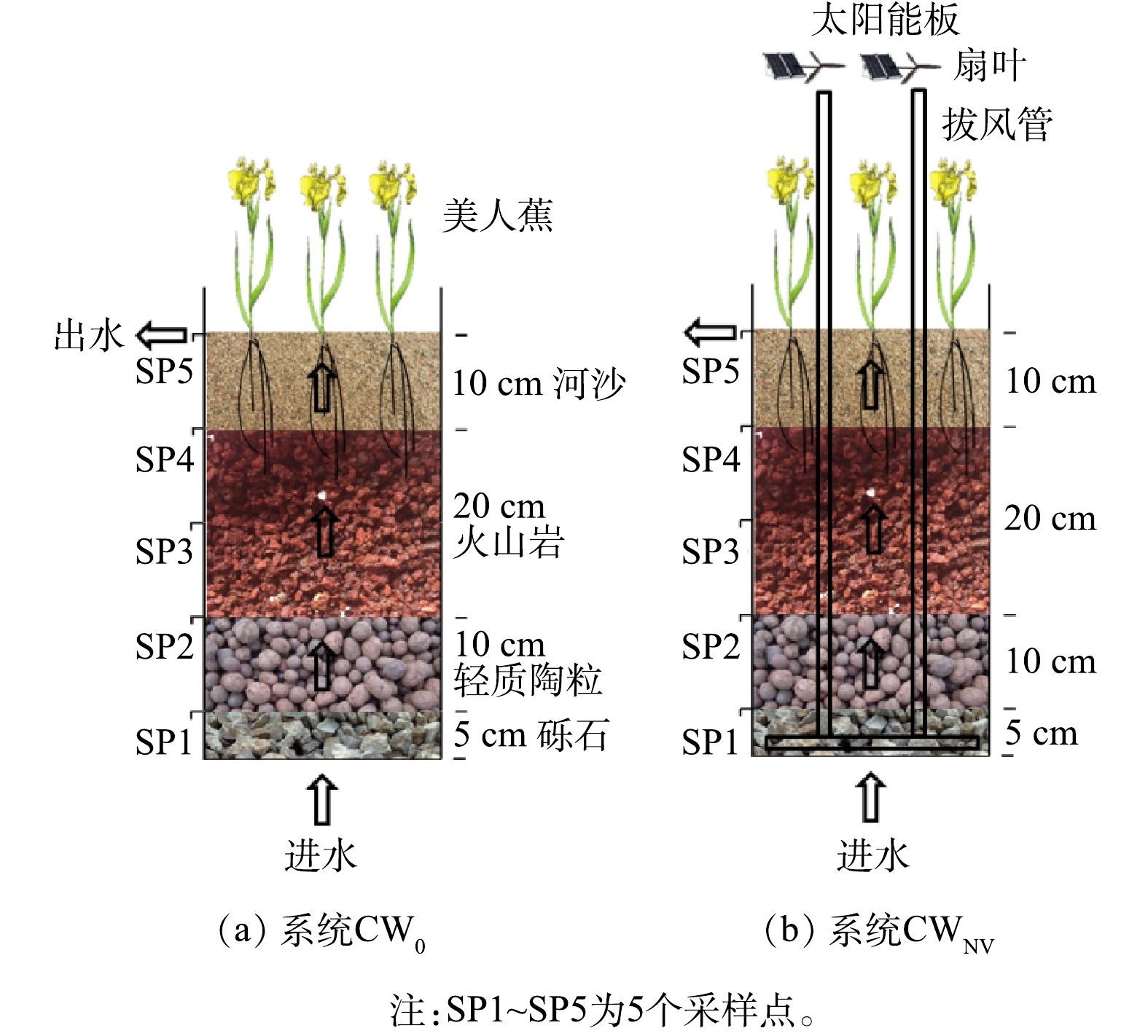
 下载:
下载:
